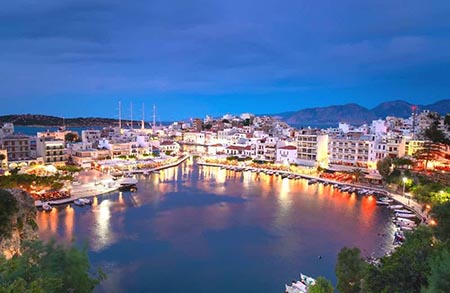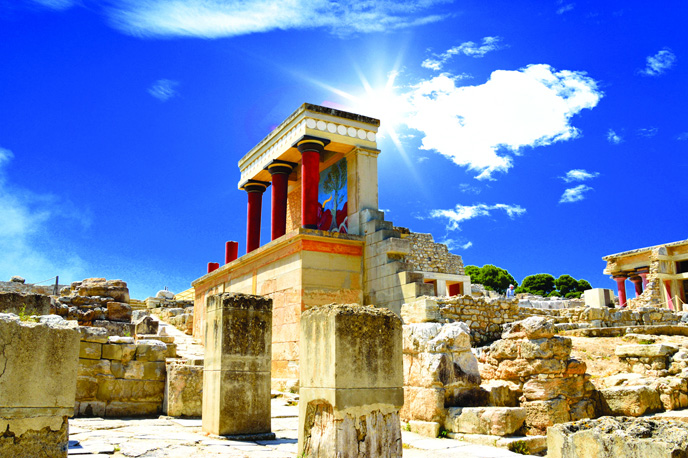
Visit Crete
This island - the largest in Greece - separates the Aegean From the Libyan Sea, marks the boundary between Europe and Africa.Majestic mountains rise in its center - the White Mountains, Psiloritis Dikti. Its plateus are split by deep gorges and end up in fertile valleys. The scenery is constantly changing. In one place harsh and barren in another wooded and gentle. Its villages smothered in greenery. Olive trees orange groves, vineyards early vegetable market gardens. Old stone farmhouses, monasteries and villages perched on mountain ridges castels and and chapels forgotten on steep slopes. Shores lined with forbidding rocks, often inaccessible, but also lots of endless sandy or pebbly beaches. Crete is renowned for the variety of its vegetation and wildlife in its chestnut, oak and cypress forests. Not to mention its palm forests (at Vai and Preveli) and its cedar forests (at Gavdos and Hrissi). Medicinal herbs and fragment shrubs - laudanum, dittany marjoran and thyme - grow in rocky areas and the mountain tops are home of the "Kri-Kri" or Cretan goat.
The main cities-ports on Crete - Chania, Rethimno Iraklio Agios Nikolaos, Sitia - all grew up on the north side, which is more benign topographically. Ierapetra is the only port on the south coast, on the shores of the Libyan Sea, facing Africa. This island's fertile soil and towering peaks witnessed the development of one of most important civilizations on Earth, the Minoan (2800-1150 BC.).


Domenicos Theotokopoulos (El Greco), Damaskinos and other iconographers paint exquisite portraits of the Virgin and Christ. Under the vaulted gates and arched windows troubadours passed singing ballads by Hortantzis about the suffering of Erotokritos and Erophili. In 1645 the Muslim conquerors set foot on the island for the first time. In 1669 the whole of Crete fell to the Turks. Not until 1913 was the island united with the rest of Greece. This island with its clear, warm sea boundless beaches lined with tamarisks, splendid plateaus and mild starry nights has more to offer than its past, its gorges, unscaled peaks and climate. Today it continues to live fully and to develop, its cities particularly changing in appearance from one day to next, in contrast to the many unchanging villages where life goes on in the same rhythm it has for centuries.
There are hundreds of cafes where one sit in the shade of a spreading plane, oak or mulberry tree and sip a "sweat" or "medium" coffee, or a glass of "tsikoudia" (raki) while playing a game of cards or "tavli" (backgammon). There are dozens of tavernas and ouzeries serving some tasty "meze", a specialty of the area. Yogurt and honey, sweet tarts (kaltzounia), pies made of wild greens flavored with fennel, fried cheese (staka), rabbit stew, cheese pie from Hora Sfakion, cockles, boiled goat. In the city of Chania, at Malaxa, at Vrisses, and other villages in the area of Rethimno, in Iraklio and its villages and in the whole district of Lassithi. Fish, sea urchins, octopus and cuttlefish cooked on coal and fried squid to be tasted at seaside tavernas. And everywhere the delectable Cretan wine. Every saint's feastday is celebrated with gusto at dozens of villages throughout the island; all Crete throbbing to the sound of the Cretan lyre and the rhythm of the local dances, the pentozali and the sousta. Meanwhile the housewives are preparing a steamed Cretan pilaf and special holiday fritters (xerotigana). In the shop windows of bustling Iraklio, picturesque Rethimno, and Chania, elegant furs, precious jewelry and artist silverware attract the visitor's attention. In the shops of lovely Sitia and tranquil Ierapetra and in mountainous Anogia one is impressed by the spread out "patanies", traditional local woven fabrics in dazzling colors, and everywhere one sees skillfully crafted ceramics and leather goods.



